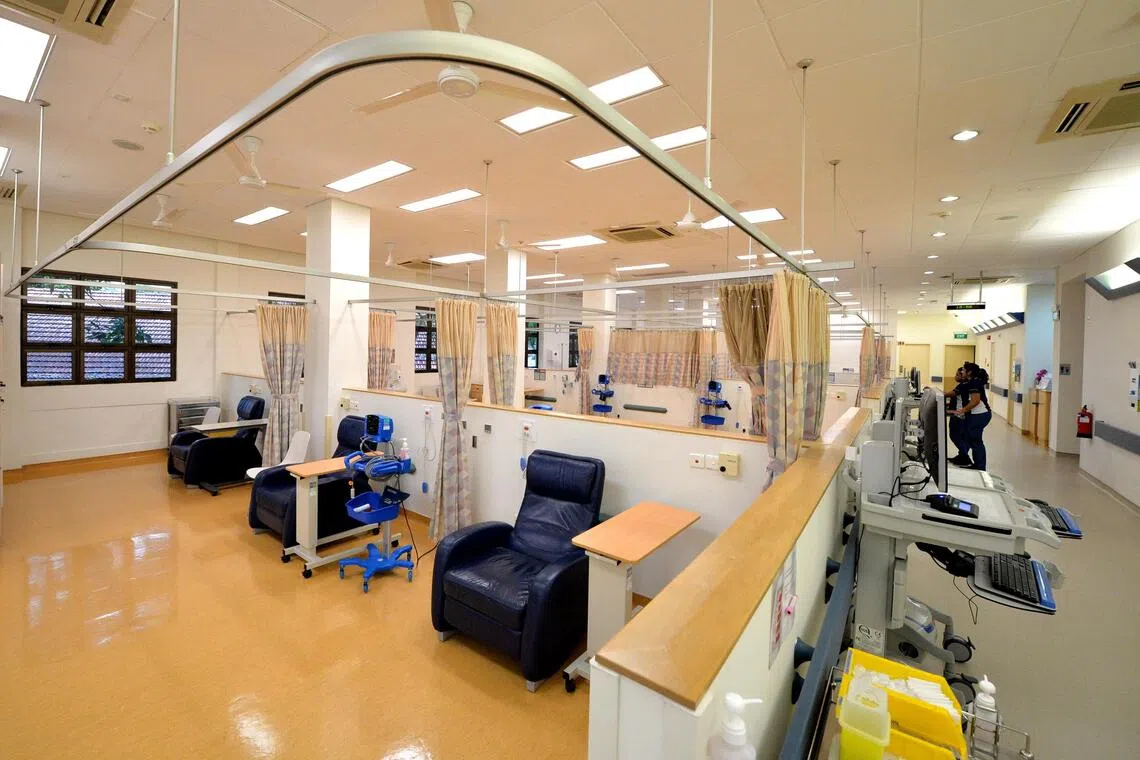One principal doctor to lead patient care; public hospital clinician scheme pay to be reviewed
Sign up now: Get ST's newsletters delivered to your inbox

Patients with multiple conditions can now be attended by a care team led by a principal doctor at several public hospitals.
PHOTO: ST FILE
Follow topic:
SINGAPORE – More public hospital patients will have one principal doctor as their main point of contact who will coordinate their care and draw expertise from relevant specialists if needed.
The principal doctor need not be a specialist. He can be a hospital clinician, whose pay will be reviewed under the new care model.
This is a departure from traditional practices, where multiple specialist-led care teams look after a patient with multiple conditions, and only specialists can be principal doctors.
This shift is set to become a norm in Singapore as public hospitals transform to cope with the growing needs of a fast-ageing population
The transformation, expected to take years, could mean fewer referrals and hospital visits for patients with complex medical needs.
Speaking at the Singapore Medical Council’s Physician’s Pledge Affirmation Ceremony on Sept 20, Health Minister Ong Ye Kung said that the default hospital care team model has been one led by specialists.
“Patients have also come to expect that the specialist – the dua lo kun – will oversee their care, regardless of their clinical needs,” Mr Ong said. The Hokkien phrase he used refers to a high-level doctor.
The current model has worked well for a much younger patient profile, but hospital visits tend to be acute and episodic, he said, adding that this will not be able to meet evolving needs.
“Now, we need to consciously train clinicians to acquire broad-based competencies as a career pathway distinct from being a specialist,” he said.
The hospital clinician scheme was introduced in 2020 to develop doctors with broad-based capabilities, so that they can anchor hospital care in a role complementary to specialists.
There are now 150 hospital clinicians across the public hospitals here, almost double the 80 as of end-2024.
To attract more doctors to become hospital clinicians, Mr Ong said the Ministry of Health (MOH) will review the remuneration of hospital clinicians and boost their career progression from three to four levels, similar to that of specialists.
Those who take on significant professional leadership responsibilities will have the chance to progress to the Apex grade, which is the fourth level, as well as be called Senior Principal Hospital Clinician.
These changes mean that there will now be three pillars to clinical practice. These are:
family physicians who develop trusted relationships with patients in the community;
hospital clinicians with broad-based capabilities to coordinate care; and
specialists who are skilled in managing specific organs and diseases.
In early 2025, MOH introduced a new care team model across selected disciplines in all public hospitals.
Alexandra Hospital, Changi General Hospital and Woodlands Health, among others, rolled out the new care model involving four disciplines – general medicine, general surgery, orthopaedic surgery and paediatric medicine.
Patients often have multiple conditions that require coordinated care across these four disciplines, whose specialists comprise more than half of all specialists in the public sector.
Public hospitals will progressively expand the new care team model to include other disciplines over the next few years. Details have not been disclosed.
Currently, an elderly person admitted to the hospital for giddiness after a fall could be referred to a neurosurgeon to check for a blood clot in the brain, a lung specialist for potential fluid in the lungs that could have caused the fall, and a kidney specialist for potential chronic kidney failure. This means he would be seen by three groups of specialist-led teams.
Under the new model, he sees just one principal doctor, who continues with his care after discharge, potentially reducing the number of referrals and visits to different specialists, MOH said.
“It is better if we can consolidate and coordinate the various treatments, and for the patient and his caregivers to have a holistic view of the patient’s health, and to be advised on an integrated care plan,” said Mr Ong.

Health Minister Ong Ye Kung speaking at the Singapore Medical Council’s Physician’s Pledge Affirmation Ceremony on Sept 20.
PHOTO: LIANHE ZAOBAO
Whether a patient is assigned to a specialist or a hospital clinician depends on the severity of his or her conditions.
For instance, a patient with advanced dementia may have a geriatrician coordinate care across various specialities, while a patient with mild dementia may be under the care of a hospital clinician.
In March 2025, MOH had said during the debate on its budget that beyond specialists, which comprise about 40 per cent of doctors, the country will increasingly need doctors of varying skillsets. These include family physicians and hospital clinicians. Doctors will need to lead care teams to manage cross-specialty issues to consolidate care for patients.

